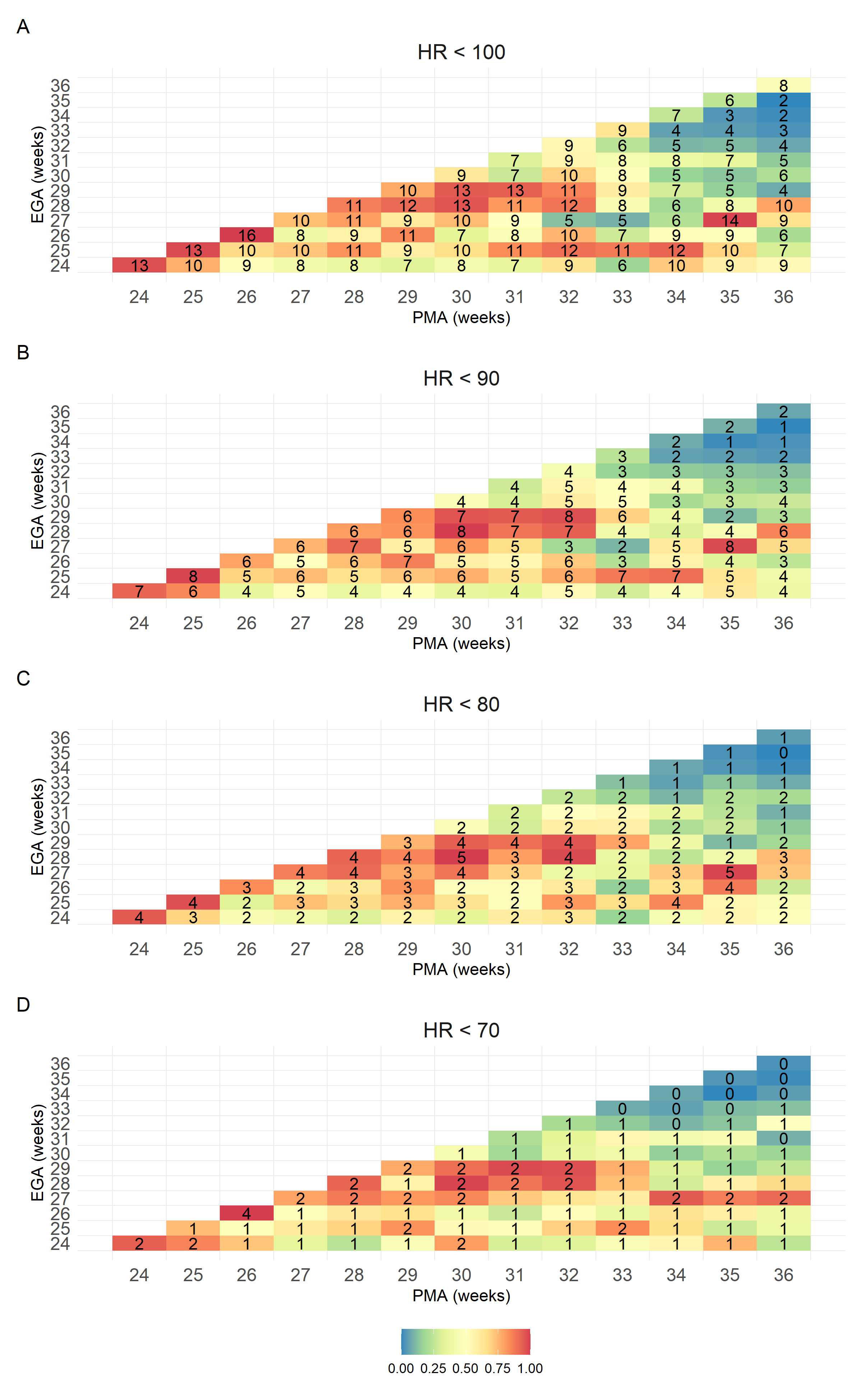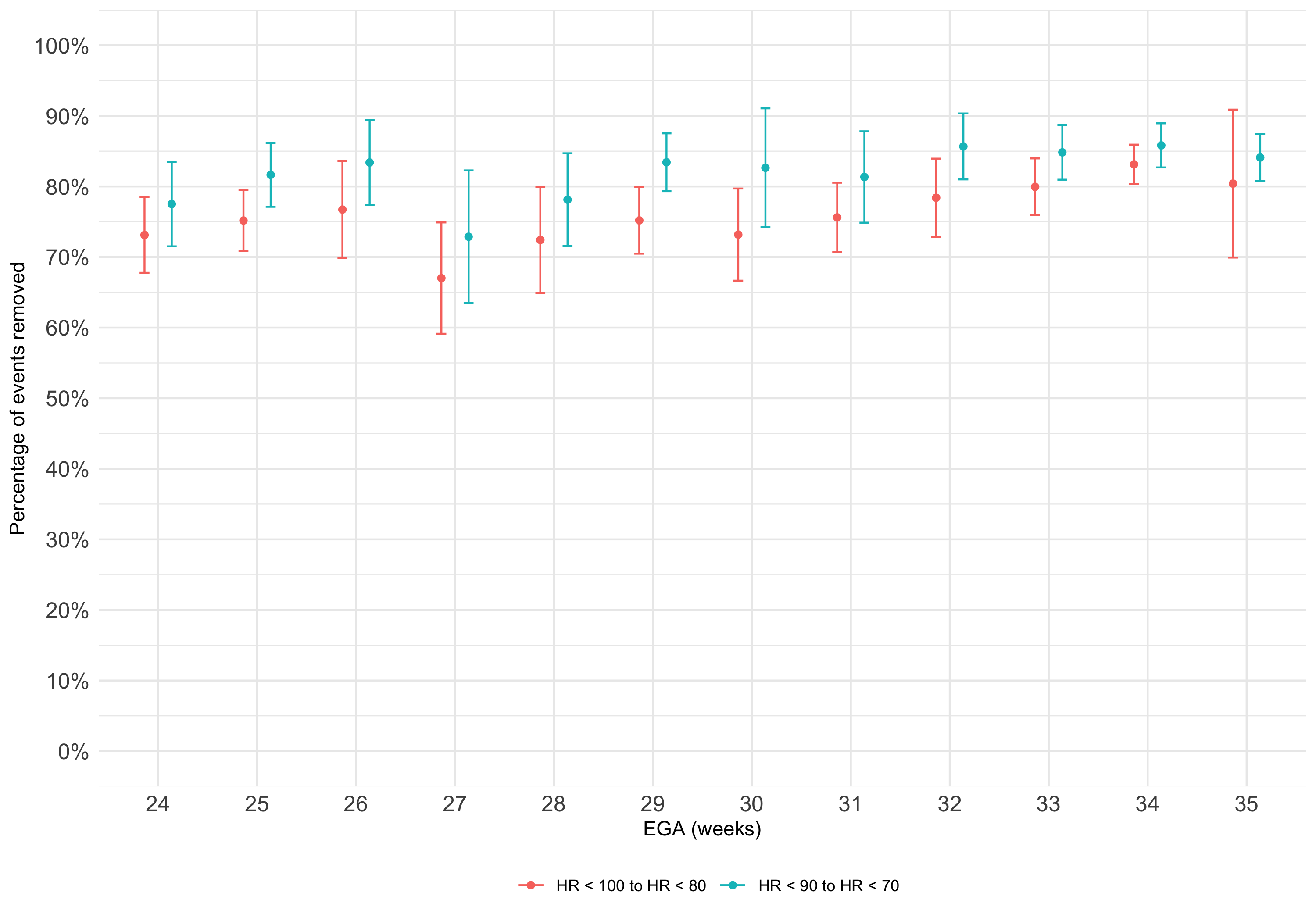Neonatal-Perinatal Health Care Delivery: Practices and Procedures
Category: Abstract Submission
Neonatal-Perinatal Health Care Delivery: Practices and Procedures - Modeling and Prediction
84 - The impact of heart rate thresholds on bradycardia alarms in the NICU
Monday, April 25, 2022
3:30 PM - 6:00 PM US MT
Poster Number: 84
Publication Number: 84.437
Publication Number: 84.437
Elizabeth B. Davis, University of Virginia School of Medicine, Charlottesville, VA, United States; VP Nagraj, University of Virginia School of Medicine, Charlottesville, VA, United States; Karen D. Fairchild, University of Virginia School of Medicine, Charlottesville, VA, United States; Robert A. Sinkin, University of Virginia Children's Hospital, Charlottesville, VA, United States; Brynne Sullivan, University of Virginia School of Medicine, KESWICK, VA, United States

Brynne A. Sullivan, MD, MSCR (she/her/hers)
Assistant Professor
University of Virginia
Charlottesville, Virginia, United States
Presenting Author(s)
Background: Bradycardia events are common among NICU patients, yet no consensus exists for heart rate alarm settings. We queried neonatologists and found variability in alarm settings for their NICUs. Higher bradycardia alarm thresholds may prevent prolonged events, yet contribute to alarm fatigue. More alarms near discharge could prolong length of stay by extending treatment or observation of apnea for prematurity.
Objective: Using archived heart rate (HR) data, describe the hypothetical alarm frequencies at four HR thresholds and explore the clinical impact of bradycardia alarms.
Design/Methods: In all infants with gestational age (GA) 24-35 weeks admitted 2012-2015, we analyzed archived every two-second HR data from the duration of their NICU stay. During the study period, the default bradycardia alarm setting in our unit was HR < 90 bpm. We identified times when HR fell below 70, 80, 90, or 100bpm for at least 4 seconds and analyzed the relative frequencies of bradycardia events. We reviewed nurse documented events (NDE) in the 2 weeks before discharge to assess the clinical impact of alarms.
Results: Data were available for 1982 infants with mean GA 24-35 weeks and mean birth weight 2.4 kg. Figure 1 shows a heat map of the number of bradycardias at each of four thresholds by gestational age and postmenstrual age. Figure 2 shows the estimated percent reduction in alarms with HR < 80 vs. HR < 100 or HR < 70 vs. HR < 90 at post-menstrual age 35w. For each scenario, the mean percent reduction in hypothetical alarms was near 75-85% and consistent across any birth GA. Chart review yielded 12,600 NDE with HR < 100bpm. We identified 180 infants (mean GA 31.7w) that had 438 NDE with HR 70-100 within 2w of discharge (mean post-menstrual age 38.5w). Of these, 73 (16.5%) had a co-occurring event (surgery, eye exam, anemia, sepsis evaluation) and 59 (32%) resulted in an extended observation period before discharge.Conclusion(s): Lowering the bradycardia alarm limit by 20 bpm could reduce the number of bradycardia alarms substantially. A prospective study would validate the safety and efficacy of this in practice.
Heatmaps of bradycardia frequency by threshold, gestational age, and PMA. Heatmaps of the number of bradycardias per day of data by estimated gestational age (EGA, y-axis) and post-menstrual age (PMA, x-axis) at four alarm thresholds: < 100bpm, < 90bpm, < 80bpm, < 70bpm. The color gradient represents bradycardia events per day of data as a percentile in each panel, representing the scale for each of the four thresholds. Numbers in each tile represent the median bradycardia rate per day of data.
Heatmaps of the number of bradycardias per day of data by estimated gestational age (EGA, y-axis) and post-menstrual age (PMA, x-axis) at four alarm thresholds: < 100bpm, < 90bpm, < 80bpm, < 70bpm. The color gradient represents bradycardia events per day of data as a percentile in each panel, representing the scale for each of the four thresholds. Numbers in each tile represent the median bradycardia rate per day of data.
Percent alarm reduction with dropping the bradycardia threshold. Percent reduction in hypothetical alarms per day of data when the threshold is dropped 20 bpm. The points represent the mean percent of hypothetical bradycardia alarms eliminated by decreasing the HR threshold from HR < 100 bpm to < 80 bpm (red) and from HR < 90 bpm to < 70 bpm (blue) and the error bars show the 95% confidence intervals.
Percent reduction in hypothetical alarms per day of data when the threshold is dropped 20 bpm. The points represent the mean percent of hypothetical bradycardia alarms eliminated by decreasing the HR threshold from HR < 100 bpm to < 80 bpm (red) and from HR < 90 bpm to < 70 bpm (blue) and the error bars show the 95% confidence intervals.
Objective: Using archived heart rate (HR) data, describe the hypothetical alarm frequencies at four HR thresholds and explore the clinical impact of bradycardia alarms.
Design/Methods: In all infants with gestational age (GA) 24-35 weeks admitted 2012-2015, we analyzed archived every two-second HR data from the duration of their NICU stay. During the study period, the default bradycardia alarm setting in our unit was HR < 90 bpm. We identified times when HR fell below 70, 80, 90, or 100bpm for at least 4 seconds and analyzed the relative frequencies of bradycardia events. We reviewed nurse documented events (NDE) in the 2 weeks before discharge to assess the clinical impact of alarms.
Results: Data were available for 1982 infants with mean GA 24-35 weeks and mean birth weight 2.4 kg. Figure 1 shows a heat map of the number of bradycardias at each of four thresholds by gestational age and postmenstrual age. Figure 2 shows the estimated percent reduction in alarms with HR < 80 vs. HR < 100 or HR < 70 vs. HR < 90 at post-menstrual age 35w. For each scenario, the mean percent reduction in hypothetical alarms was near 75-85% and consistent across any birth GA. Chart review yielded 12,600 NDE with HR < 100bpm. We identified 180 infants (mean GA 31.7w) that had 438 NDE with HR 70-100 within 2w of discharge (mean post-menstrual age 38.5w). Of these, 73 (16.5%) had a co-occurring event (surgery, eye exam, anemia, sepsis evaluation) and 59 (32%) resulted in an extended observation period before discharge.Conclusion(s): Lowering the bradycardia alarm limit by 20 bpm could reduce the number of bradycardia alarms substantially. A prospective study would validate the safety and efficacy of this in practice.
Heatmaps of bradycardia frequency by threshold, gestational age, and PMA.
 Heatmaps of the number of bradycardias per day of data by estimated gestational age (EGA, y-axis) and post-menstrual age (PMA, x-axis) at four alarm thresholds: < 100bpm, < 90bpm, < 80bpm, < 70bpm. The color gradient represents bradycardia events per day of data as a percentile in each panel, representing the scale for each of the four thresholds. Numbers in each tile represent the median bradycardia rate per day of data.
Heatmaps of the number of bradycardias per day of data by estimated gestational age (EGA, y-axis) and post-menstrual age (PMA, x-axis) at four alarm thresholds: < 100bpm, < 90bpm, < 80bpm, < 70bpm. The color gradient represents bradycardia events per day of data as a percentile in each panel, representing the scale for each of the four thresholds. Numbers in each tile represent the median bradycardia rate per day of data.Percent alarm reduction with dropping the bradycardia threshold.
 Percent reduction in hypothetical alarms per day of data when the threshold is dropped 20 bpm. The points represent the mean percent of hypothetical bradycardia alarms eliminated by decreasing the HR threshold from HR < 100 bpm to < 80 bpm (red) and from HR < 90 bpm to < 70 bpm (blue) and the error bars show the 95% confidence intervals.
Percent reduction in hypothetical alarms per day of data when the threshold is dropped 20 bpm. The points represent the mean percent of hypothetical bradycardia alarms eliminated by decreasing the HR threshold from HR < 100 bpm to < 80 bpm (red) and from HR < 90 bpm to < 70 bpm (blue) and the error bars show the 95% confidence intervals.